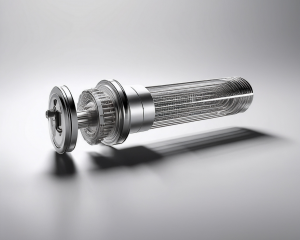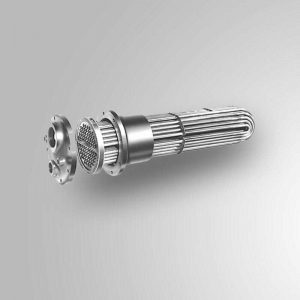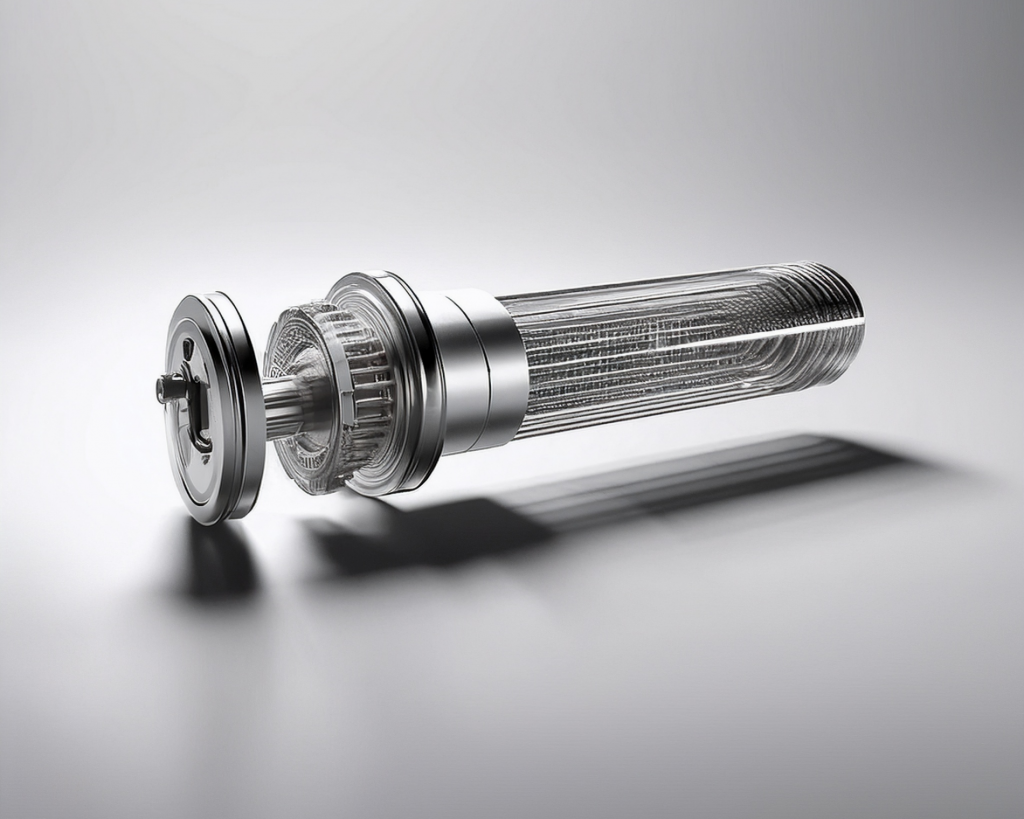Shell and Tube Heat Exchangers in the Pharmaceutical Industry: Efficiency and Applications
1. Definition and Basic Working Principles of Shell and Tube Heat Exchangers
Shell and tube heat exchangers are mechanical devices that provide heat transfer between two different fluids. They are widely used, especially in sterile production processes in the pharmaceutical industry, for heating and cooling operations. The working principle is based on one fluid moving inside the tubes while the other circulates outside the tubes (usually within a shell).
1.1. Heat Transfer Mechanism
In shell and tube heat exchangers, heat transfer occurs through three basic methods:
- Conduction: Heat flow through the tube material.
- Convection: Heat exchange through the movement of fluids.
- Radiation: A factor that is generally neglected in the pharmaceutical industry but is important in some special cases.

1.2. Structural Features of Shell and Tube Heat Exchangers
Shell and tube heat exchangers typically consist of the following components:
- Tube Bundle: The tubes that provide heat transfer.
- Shell: The main body where the fluid outside the tubes circulates.
- Inlet and outlet connections: The entry and exit points for the fluids.
2. The Importance of Shell and Tube Heat Exchangers in the Pharmaceutical Industry
Temperature control is of critical importance in pharmaceutical manufacturing. Ensuring that chemical reactions occur at the correct temperature ensures that products remain stable and their effectiveness is preserved.
2.1. The Effect of Temperature Control on Product Quality
- Prevents the degradation of active ingredients.
- Optimizes chemical reactions.
- Maintains correct viscosity and solubility levels.
2.2. Hygiene and Sterilization Requirements
- Shell and tube heat exchangers in the pharmaceutical industry must comply with GMP (Good Manufacturing Practices) standards.
- They must be cleanable with CIP (Clean-In-Place) and SIP (Sterilize-In-Place) systems.

3. Types and Applications of Shell and Tube Heat Exchangers
3.1. Single-Pass and Multi-Pass Shell and Tube Heat Exchangers
- Single-pass: The fluid passes through the tubes once and exits.
- Multi-pass: The fluid changes direction multiple times within the tubes, covering a longer path, thus achieving better heat transfer.
3.2. Shell & Tube Heat Exchangers
- Resistant to high temperature and pressure conditions.
- Ideal for liquid-liquid or gas-liquid heat transfer.
3.3. Double-Pipe Heat Exchangers
- Preferred in smaller-scale pharmaceutical production processes.
- Offers low maintenance costs and easy cleanability.
4. Material Selection and Corrosion Resistance
Correct material selection is critically important for shell and tube heat exchangers to operate for a long time and efficiently in the pharmaceutical industry. The materials used must be suitable for sterilization processes, show resistance to chemical substances, and be resistant to corrosion.
4.1. Stainless Steel and Other Material Options
The most commonly used material in the pharmaceutical industry is 316L stainless steel. The main reasons for this are:
- High corrosion resistance: Especially resistant to acidic and basic chemicals.
- Easy cleanability: Suitable for CIP (Clean-In-Place) and SIP (Sterilize-In-Place) processes.
- Biocompatibility: Complies with GMP (Good Manufacturing Practices) and FDA standards.
Alternative material options:
- Titanium: Offers excellent resistance to corrosive chemicals, but its cost is high.
- Hastelloy: Can be used at high temperatures and in aggressive environments.
- PTFE-coated tubes: Preferred for the transfer of adhesive products.
4.2. Corrosion Prevention Methods
Various corrosion prevention methods can be applied to extend the life of shell and tube heat exchangers:
- Regular cleaning and maintenance: CIP/SIP processes must be correctly implemented to prevent biofilm and sediment accumulation.
- Coating applications: PTFE or epoxy coatings can be applied to surfaces in contact with chemical substances.
- Material selection: The risk of corrosion can be minimized by using materials suitable for the application conditions.
5. Design Criteria for Shell and Tube Heat Exchangers in the Pharmaceutical Industry
Shell and tube heat exchangers are designed according to specific engineering criteria to ensure optimal performance in pharmaceutical production processes.
5.1. Surface Area and Heat Transfer Coefficient
- The heat transfer surface area is calculated to maximize heat exchange.
- To ensure a high heat transfer coefficient, tube diameter, tube wall thickness, and material conductivity are taken into account.
5.2. Flow Rate and Pressure Drop Calculations
- Excessive pressure drop can increase pumping costs and reduce system efficiency.
- Optimal flow rate is achieved by selecting a tube diameter suitable for the fluid’s viscosity.
These calculations are supported by CFD (Computational Fluid Dynamics) simulations to ensure optimal performance.
6. Advantages and Disadvantages of Shell and Tube Heat Exchangers
The advantages and some disadvantages of using shell and tube heat exchangers in the pharmaceutical industry can be listed as follows:
6.1. Advantages
✅ High efficiency: Provides effective heat transfer thanks to a large surface area.
✅ Durability: Resistant to high temperature and pressure conditions.
✅ Easy maintenance: Parts can be replaced thanks to the modular design.
✅ Wide application area: Can be used in liquid-liquid, gas-liquid, and even solid-liquid systems.
6.2. Disadvantages
⚠ Initial investment cost can be high: Materials like stainless steel or titanium can be costly initially.
⚠ Tube blockages: Viscous or particle-containing liquids can cause blockages over time.
⚠ Large space requirement: Some types of heat exchangers can take up a lot of space.
7. Maintenance and Cleaning of Shell and Tube Heat Exchangers
To ensure hygienic conditions in pharmaceutical production, shell and tube heat exchangers need to be regularly cleaned and maintained.
7.1. CIP (Clean-In-Place) and SIP (Sterilize-In-Place) Processes
- The CIP system allows shell and tube heat exchangers to be cleaned without disassembly.
- The SIP system prevents microorganism formation with high-temperature steam or chemical sterilization.
7.2. Prevention of Fouling and Blockages
- Use of high-purity water (WFI – Water for Injection)
- Maintenance of periodic filtration systems
- Regular cleaning of the inner surfaces of the tubes
8. Application Examples in Pharmaceutical Production
Shell and tube heat exchangers are used effectively in various processes in pharmaceutical production.
8.1. API Production and Cooling Processes
During the production of Active Pharmaceutical Ingredients (API), the temperatures of chemical reactions need to be controlled. Thanks to shell and tube heat exchangers:
- Overheating is prevented.
- Reaction efficiency is increased.
8.2. Use in Liquid Drug Formulations
- Temperature-controlled production of syrups and suspensions
- Sterilization processes in the production of vaccines and biotechnological drugs
9. Compliance of Shell and Tube Heat Exchangers with Regulations
All equipment used in the pharmaceutical industry must comply with certain standards.
9.1. GMP (Good Manufacturing Practices) Standards
- Cleanability and sterilization requirements
- Biocompatibility of surfaces in contact with the product
9.2. FDA and European Union Regulations
- FDA 21 CFR Part 211: Rules for equipment use in pharmaceutical manufacturing
- EU GMP Annex 15: Validation processes for heat exchanger systems
10. Future Technologies and Innovations in Shell and Tube Heat Exchangers
Shell and tube heat exchangers in the pharmaceutical industry are constantly evolving.
10.1. Smart Sensors and IoT Integration
- Real-time temperature and flow rate monitoring
- Automated maintenance systems
10.2. Eco-Friendly Heat Exchange Systems
- Lower energy consumption
- Systems compatible with carbon-neutral production processes
Conclusion and General Assessment
Shell and tube heat exchangers are one of the critical pieces of equipment in the pharmaceutical industry. Thanks to their high efficiency, hygienic designs, and durability, they are widely used in pharmaceutical production processes that require temperature control.
In the future, with the development of smarter and more eco-friendly systems, the use of shell and tube heat exchangers will become even more widespread.


